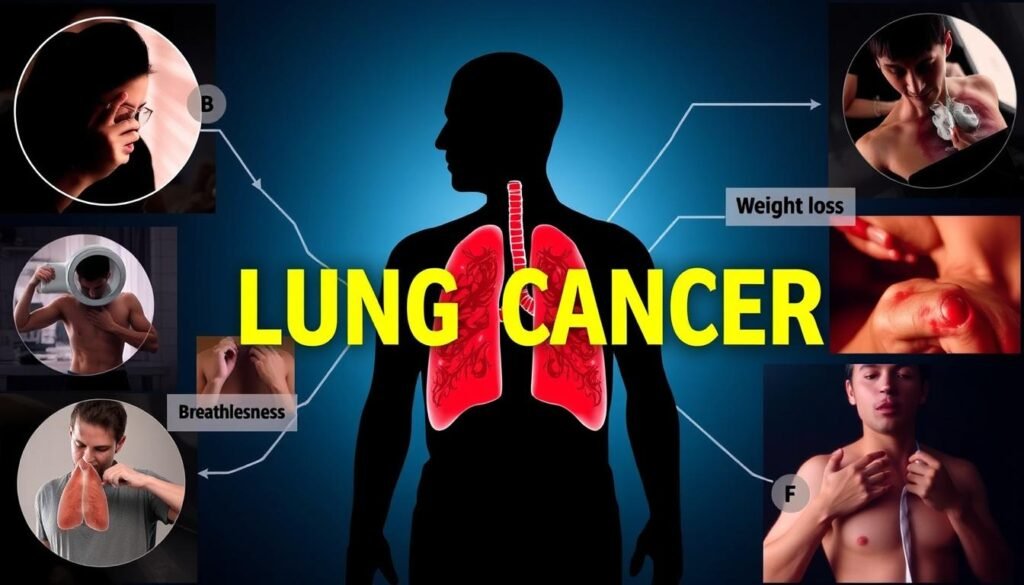Lung cancer is the top killer, with 85% of cancer deaths in the U.S. linked to it. Often, lung cancer shows no signs until it’s advanced. So, many ask, “does lung cancer cause fever?” Knowing what symptoms to look for is key to catch lung cancer early for better treatment outcomes. Spotting these signs early could be life-saving.
We’re going to explore how lung cancer and its symptoms, like fevers, are connected. Whether you’re dealing with a diagnosis or helping someone who is, knowing about these symptoms is vital. It helps you make smart choices about your health.
Key Takeaways
- Most lung cancers do not show symptoms until they have spread.
- Early diagnosis of lung cancer significantly increases treatment effectiveness.
- The most common symptoms include persistent cough, unexplained weight loss, and chest pain.
- Lung cancer can lead to syndromes affecting nerves and hormones.
- Smoking remains the biggest risk factor, accounting for over 85% of cases.
- Awareness of symptoms can aid in prompt medical consultation and potential diagnosis.
Understanding Lung Cancer
Lung cancer is a major health issue that affects many in the U.S. Knowing the different types and risk factors is key. This knowledge is vital to fight the disease effectively.
Types of Lung Cancer
Lung cancer comes in two types: small cell (SCLC) and non-small cell (NSCLC). NSCLC is more common, making up about 80-85% of cases. It grows slower than SCLC. Spotting these cancers early is essential for successful treatment.
Prevalence and Risk Factors
Lung cancer is very common in the United States, second only to skin cancer. It has many risk factors such as:
- Smoking: This is the cause of nearly 90% of cases in men and 78% in women.
- Secondhand Smoke: It’s linked to around 7,000 lung cancer deaths each year.
- Exposure to Radon: This gas can build up in houses, increasing cancer risk.
- Asbestos Exposure: Exposure to this carcinogen is linked with lung cancer.
- Genetic Predisposition: A family history of lung cancer can raise your risk.
Knowing these risk factors helps in prevention and early detection. It’s also important to look out for early warning signs. Finding them early can improve the odds of successful treatment.
Common Symptoms of Lung Cancer
Lung cancer can make everyday life hard due to its symptoms. Knowing these symptoms helps catch the disease early and improve survival chances. In later stages, symptoms become worse, while early signs might not be noticeable.
Early-Stage Symptoms
In early lung cancer, especially non-small cell lung cancer, symptoms are not always obvious. Early signs include:
- Persistent coughing without a discernible cause
- Cough producing blood or red-colored phlegm (hemoptysis)
- Chest pain or pain during breathing
- Difficulty breathing or shortness of breath
- Fatigue or feeling unusually weak
- Hoarseness or wheezing
Many might not see a doctor when these early signs show up. If you have a long-lasting cough, it’s vital to talk to a doctor for possible checks. More about symptoms can be explored at this resource.
Advanced-Stage Symptoms
When lung cancer gets worse, it causes severe symptoms. Advanced symptoms include:
- Bone pain affecting daily activities
- Persistent headaches or dizziness
- Weight loss that is unexplained
- Jaundice, indicating liver involvement
- Lumps in the neck or collarbone region
Acting on these severe signs quickly is key to getting help fast. Signs like tiredness, ongoing cough, and sudden weight loss are important. Other body areas might be hit by NSCLC, making the situation more complex.
Does Lung Cancer Cause Fever?
It’s important to know how lung cancer and fever are related, especially for those affected. While fever isn’t always linked to lung cancer, it can appear under certain conditions. It’s crucial to look at the disease stage and complications to figure out if lung cancer causes the fever.
How Fever Might Occur in Lung Cancer Patients
Fever in lung cancer patients can come from different sources. It could be due to a tumor or infections after chemotherapy. As the lung cancer advances, especially in late stages, fever becomes more common. This is often a reaction to the tumor spreading or side effects from treatment.
Fever, which is a temperature above 100.4°F (38°C), might be the body fighting cancer. Treatments that lower white blood cells can also make infections more likely.
Comparing Lung Cancer with Other Cancers Associated with Fever
Fever is a well-known symptom of some cancers like leukemia and lymphoma. Lung cancer fevers are different from these cancers. Leukemia patients, for example, often have fevers from low white blood cell counts. This is rarer in lung cancer patients.
Leukemia and Hodgkin lymphoma can cause ongoing fevers, which suggests the disease is getting worse. This isn’t usually the case with lung cancer. Knowing these differences is important for tracking symptoms and caring for patients.
Understanding Fever in Cancer Patients
Fever in cancer patients is a complex issue. It often involves various factors. Understanding the fever causes in cancer patients helps identify why temperatures rise. Fever usually happens due to the cancer, treatment reactions, and infections and fever.
What Causes Fever in Cancer Patients?
Fever in cancer patients signals several problems. The tumor’s inflammatory response is a key factor. It can cause fever through neoplastic processes, releasing inflammatory substances. Treatments like chemotherapy may weaken the immune system, making infections more likely and causing fever.
The Role of Infections
Infections significantly affect cancer patients’ fevers. Treatments can lower bone marrow function. This leads to neutropenia, increasing infection risk. Patients face bacterial, viral, and fungal infection risks. These infections can cause fevers. It’s crucial to identify and treat infections early to avoid complications.

| Type of Condition | Percentage of Fever Cases |
|---|---|
| Cancer (1961) | 19% |
| Cancer (2007) | 7% |
| Leukemia | 25% |
| Renal Cell Carcinoma | 20% |
It’s vital to understand these factors for good management. If a patient has a fever after treatment, they should watch their temperature. They must seek help if it goes over 37.5°C (99.5°F).
Fever as a Symptom of Tumor Progression
Fever can indicate tumor growth, especially in lung cancer patients. It suggests that the body’s temperature rises due to tumor development. This information is key for understanding the patient’s condition.
What is Tumor Fever?
Tumor fever is caused when cancer releases substances that make the body warmer. It’s more common with big tumors. Knowing about tumor fever helps tell it apart from infection-related fevers, which worries many cancer patients.
How Tumor Size and Progression Relate to Fever
The bigger a tumor gets, the more likely fever will occur. This link is clear in advanced lung cancer. Tracking temperature can show if treatment is working and if changes are needed.
| Factor | Influence on Fever |
|---|---|
| Tumor Size | Increased release of pyrogenic substances |
| Tumor Type | Varied fever responses; lung tumors often cause more pronounced fever |
| Treatment Stage | Changes in fever patterns may indicate treatment efficacy or progression |
| Metastasis | Additional tumor sites can exacerbate fever symptoms |
Understanding how tumor growth affects fever is crucial for lung cancer care. For more about this topic, see the research on psychogenic fever in cancer patients. It highlights how mental well-being plays a role in managing fever.
Related Symptoms of Lung Cancer
Spotting lung cancer’s symptoms early can help with starting treatment sooner. Symptoms include a lasting cough, feeling short of breath, and feeling very tired. It’s important to pay attention to these signs, especially if you also have a fever.
Cough and Shortness of Breath
Lung cancer may start with a cough that doesn’t go away and gets worse. Even people who have never smoked can have a cough that sounds like a smoker’s cough. As cancer grows, you might find it hard to breathe during everyday tasks. Don’t ignore these signs; they could be pointing to lung cancer and need a doctor’s check.
Fatigue and Weight Loss
Feeling very tired, more than usual, is a common sign of cancer. This tiredness happens because your body is always fighting cancer. It’s not just about being tired; it can also include stress and side effects from cancer treatments. Along with feeling tired, you might start losing weight without trying. This happens because you’re not as hungry and your body is changing how it uses energy. Paying attention to these signs is key for treating and tracking your health.

| Symptom | Description | Importance |
|---|---|---|
| Cough | Persistent and worsening cough over time. | Key warning sign of lung cancer. |
| Shortness of Breath | Difficulty breathing during daily activities. | Indicates potential lung function impairment. |
| Fatigue | Extreme tiredness not relieved by rest. | Can signal disease progression or treatment effects. |
| Weight Loss | Unintended weight drop due to appetite loss. | May indicate advanced stages of cancer. |
Evaluating Fever in Lung Cancer Patients
Fever can mean many things for someone with lung cancer. It’s important to keep track of how long the fever lasts and any other health changes. Figuring out when to ask for help can make getting better faster.
When to Seek Medical Attention
Knowing when to get help for a fever is key for patients with lung cancer. Look out for signs like:
- Fever over 38°C (100.4°F) that hangs around
- Being really tired, a bad cough, or more trouble breathing
- Feeling chills or seeing something unusual like a discharge
- Getting confused or not thinking clearly
Diagnostic Tests and Procedures
Doctors use tests to understand fever in lung cancer patients better. Some common tests include:
| Test Type | Purpose |
|---|---|
| Blood Tests | Look for infections or blood issues |
| Imaging Scans | Find infections or tumor problems |
| Biopsies | Check for cancer cells or other diseases |
Knowing about these tests helps in dealing with fever in lung cancer. Early problem finding means better care.
Treatment Options for Fever in Cancer Patients
Handling fever in cancer patients involves a complete approach. This includes treating the root infections and tackling complications from cancer treatments. Effective strategies are crucial to improve outcomes and keep patients safe.
Managing Infections
Infection control is vital for cancer patients, especially with fever. Their weakened immune system from cancer or treatments ups infection risks. A fever over 100.4°F needs quick medical action for the cause. Health professionals often perform urine and blood tests for bacterial infections. Antibiotics may be used to ease symptoms and clear the infection. When on chemotherapy, monitoring temperature every 2-3 hours is recommended to prevent complications.
Psychogenic Fever Considerations
Psychogenic fever in cancer patients can be due to stress from their condition and treatment. It highlights how crucial mental health is in cancer care. Dealing with psychogenic fever might include therapy and relaxation to lower stress. Thus, understanding the mental side of fever management is essential for patient recovery.

Fever’s impact on cancer patients goes beyond just symptoms. Knowing both infection control and the mental health side is key for a holistic treatment strategy. Concentrating on these areas promises better outcomes and life quality for the patients.
| Fever Type | Common Causes | Treatment Approaches |
|---|---|---|
| Infectious Fever | Bacterial infections, chemotherapy effects | Antibiotics, hospitalization, monitoring |
| Tumor Fever | Cancer progression, pyrogens | Palliative care, symptom mgmt |
| Psychogenic Fever | Stress, anxiety | Counseling, relaxation techniques |
Psychogenic Fever in Cancer Patients
Psychogenic fever is a situation that some people face, especially when under a lot of stress or emotional pain. It’s particularly important to understand this in cancer patients. They go through a lot emotionally, which can affect their physical health. Psychogenic fever definition is about body temperature going up due to stress, not because of infection or the cancer itself. This makes things more complex for cancer patients, as they deal with both emotional and physical issues.
Defining Psychogenic Fever
Psychogenic fever can happen to anyone between the ages of 3 and 56, with almost equal numbers of males and females affected. Studies show that stress, whether short-lived or ongoing, can change body temperature. Short-term stress might cause a quick rise in temperature. But long-lasting stress can lead to a continuous, mild fever. In patients with lung cancer, fever can be from several causes like infection, the cancer getting worse, or stress from the illness.
Take the case of a 61-year-old man with lung cancer, for instance. He had fevers that came and went, trouble sleeping, and heart palpitations. After being checked for anxiety, he was treated with medication for it. This helped get rid of the fever and other issues. This case shows how cancer and stress-related symptoms can be connected.
Understanding psychogenic fever in cancer patients helps in treating them better. It helps in looking after both their minds and bodies. Knowing what causes a fever is key to giving them the care they need during treatment.
Conclusion
Lung cancer and fever are closely linked, which is crucial for both patients and doctors to understand. Fever in lung cancer patients is seen in about 10 to 40% of cases. Often, these fevers are due to infections by Gram-negative bacteria.
Knowing the signs of fever in lung cancer is key. It can show infections that might make treatment harder. Plus, fever can be a clue that the cancer is getting worse or that there are other issues, like bacteremia or anemia.
Treating fever in lung cancer usually involves antibiotics. This method works about 83% of the time for patients with febrile neutropenia.
Being more aware of lung cancer and fever helps in diagnosing symptoms early. Early diagnosis can lead to better treatment results. This improves life quality for those dealing with this hard disease. By focusing on these aspects, survival rates may increase and patients can make informed treatment choices.